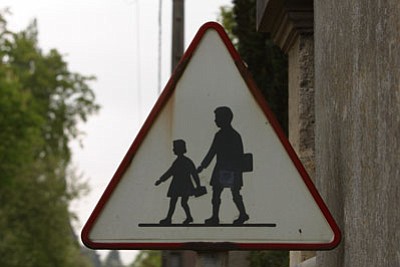This article is part of the #STCPreventionMatters campaign from the R Adams Cowley Shock Trauma Center, University of Maryland. For more information about the campaign and the Center for Injury Prevention and Policy, visit: umm.edu/PreventionMatters.
When summer ends and school begins, the roads fill with people returning from vacation and getting back to work or school. Estimates vary, but parents taking their children to and from school make up a large part of the increased traffic delays we see on the roads after Labor Day. Everyone is busy or in a hurry and may be more focused on getting to their next destination and not on the steps needed to get there safely.
It may be easy to identify the risks that come with swimming in the ocean or falling off the monkey bars, but the dangers of getting to and from school are less obvious.
More school-aged children are killed from 6 a.m. to 8 a.m. and from 3 p.m. to 4 p.m. than at any other time during the day. More than one third of these deaths are walkers between the ages of eight and 13 (NHTSA, 2017).
As children, we are taught the basics of crossing the street safely; but as a doctor in the Pediatric Emergency Department, I see that parents and children forget to follow some of those simple rules. With the days getting shorter and travel times getting longer, I strongly urge parents to keep in mind a few simple tips to keep everyone safe:
•Know your child— Not all children are ready to start walking to school at the same age. They must first show good judgement and maturity. In general, children are ready to start walking to school between the ages of nine and 11. Children under age 10 may have difficulty judging the speed or distance of oncoming cars. Others may not pay close enough attention and go into busy traffic, therefore requiring adults to help them get to school safely.
•Map out a safe path to school— Parents should be aware of safe crossing spots or crosswalks on the way to school. Parents should also keep in mind that the flow of traffic can be very different depending on the time of day. When possible, walkers should use sidewalks and cross at corners using traffic signals as instructed. If there are no sidewalks, SafeKids recommends walking facing traffic as far to the left as possible. Busy streets can mean more cars, and perhaps more distracted drivers. So again, think about having a responsible adult, sibling or friend to go with the younger student.
•Practice makes perfect— If your child is starting at a new school, walk with them until you feel that they are confident with the route and can get to school safely. This is also a perfect opportunity to review the rules of being a responsible pedestrian: look left, right and then left again before crossing a street. Then continue to look until you are safely across. For the older student, remind them to put away the cell phone or device while walking— a distracted pedestrian and the potential for a distracted driver is a recipe for disaster.
•Make sure people can see your child— Use brightly colored clothing or armband reflectors to make the walking child more visible to drivers. Look for other children in your neighborhood that can be a buddy on the way to school. You could even organize a “Walking School Bus” where an adult walks a group of neighborhood children to school and picks up more friends on the way.
Following these tips will likely help our children get to school and home safely.
October 10 is National Walk/Bike to School Day so use this day to practice some of these tips and talk to your students about traveling safely.
Richard Lichenstein, MD, is a professor of pediatrics at the University of Maryland School of Medicine, a pediatric emergency physician at the University of Maryland Medical Children’s Hospital, chair of the Teen Safe Driving Coalition in Maryland and chair of the State Child Fatality Review Team.
